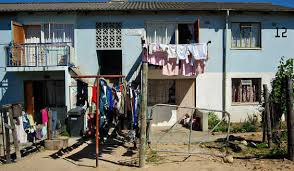 The other day I received an email flyer from a commercial broker trying to sell an apartment building. The commercial broker boasted that this potential investment offered a whopping cap rate of 14%. The first thought that passed through my head was that this property was almost certainly in a war zone.
The other day I received an email flyer from a commercial broker trying to sell an apartment building. The commercial broker boasted that this potential investment offered a whopping cap rate of 14%. The first thought that passed through my head was that this property was almost certainly in a war zone.
It's very hard for commercial mortgage brokers to close commercial real estate loans in war zones. Few commercial lenders want to make commercial real estate loans in high-crime-rate, high-drug-use neighborhoods, if for no other reason than the justifiable fear that a vacant, foreclosed commercial property may be quickly vandalized and stripped of its copper. (Been there, suffered this far too often.) Therefore the wise commercial loan broker will be sensitive to any clues that might tip him off that he is unlikely to get paid for his hard work on a deal.
You will recall that a cap rate is simply the return on his money that an investor would earn if he paid all cash for an income property. It's the Net Operating Income (NOI) from a rental property divided by its Purchase Price (times 100% to express the decimal as a percentage).
For example, suppose a five-plex generates $37,432 in annual Net Operating Income. An investor pays $730,000 for this five-plex. To compute the cap rate, simply divide $37,432 by $730,000. The result is 0.051. If you multiply this decimal by 100%, you get an answer that is easy to understand - 5.1%. In plain English, the investor will earn an annual 5.1% return on his money.
Okay, if you were an investor, and all the properties were roughly similar, would you rather earn 5.1% on your money or 14.0%? Uh... is this a trick question? Obviously, if all else is equal, investors would greatly prefer to earn the higher return on their money.
But what if you personally had to collect the rent every month, and people were being shot down on a regular basis in that neighborhood? "Oh. In that case, I'll take the 5.1% return rather than the more dangerous 14.0% return. The extra 9% return may not be worth dying for."
----------------------
True Story: Thirty years ago I am doing a site inspection on an apartment building in San Jose. I stepped back to capture more of the building in my camera. As I did, my foot slipped in a mud puddle... except it wasn't mud. It was a pool of congealed blood from a fatal knife fight the night before! The victim's bloody handprints were even visible on a nearby car, as he slid to his death. Eeuuuu!
-----------------
Therefore, when I saw the 14% cap rate on that apartment building being marketed, my first thought was, "I'll bet this is a high-crime-rate, high-drug-use area."

Here's another concept I learned only this year. Just like poor-credit car buyers often have to pay much more for cars than good-credit car buyers, apartment renters in the ghetto often pay more per square foot in rent than far more affluent folks in middle class areas. Here's why:
Renting an apartment on the safer, more affluent side of the tracks requires a steady job and good credit. A great many ghetto residents lack a steady job and good credit, so they don't qualify. They therefore have to live in an apartment where poor credit will be accepted. It is ironic, but often apartments in the poorer areas of town will rent for more money per square foot than those in the rich areas.
In defense of the landlords, collection losses from poor-credit renters are often very, very high - as much as 30% to 40% of the scheduled rent. New tenants may pay their rent for a few months, but then they often stop paying. These poor-quality tenants next live in the apartments rent-free for 90 to 120 days, as the eviction process slowly inches its way through the courts. When they finally leave, they often cause far more property damage than the size of their meager security deposits.
The landlords therefore have little choice but to charge poor-credit renters a sizable rent premium. A 2-bedroom, 1 bath apartment might rent for $800 per month in a safe, middle-class area. The same-sized apartment might rent for $975 per month in the ghetto.
Therefore, whenever you are working on a commercial loan, be very careful of properties that sell for high cap rates or which have impressive-looking debt service coverage ratios. These properties may be located in neighborhoods where the landlords are charging a big rent premium. Such properties may have impressive rent rolls, but the landlords seldom collect more than 60% to 70% of their scheduled rent.
If you're the typical commercial loan broker, you work 100% on commission. Right or wrong, commercial lenders will look for any legal excuse not to lend in high-crime-rate, high-drug-use neighborhoods. When you get a commercial loan on a property selling at a very high cap rate or which cash flows unusually well, you are on notice. This commercial property is probably in a high-crime-rate, high-drug-use area. This commercial loan will be hard to place.




